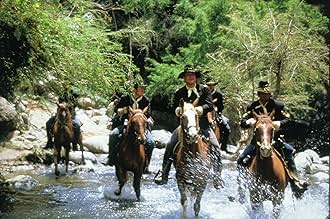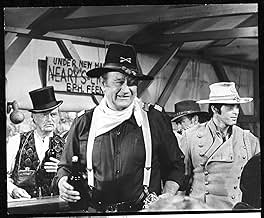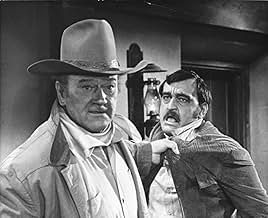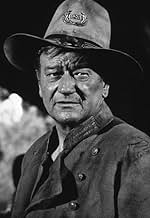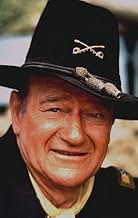IMDb-BEWERTUNG
6,7/10
14.679
IHRE BEWERTUNG
Nach dem Bürgerkrieg sucht Cord McNally nach dem Verräter, dessen Verrat die Niederlage von McNallys Einheit und den Verlust eines engen Freundes verursacht hat.Nach dem Bürgerkrieg sucht Cord McNally nach dem Verräter, dessen Verrat die Niederlage von McNallys Einheit und den Verlust eines engen Freundes verursacht hat.Nach dem Bürgerkrieg sucht Cord McNally nach dem Verräter, dessen Verrat die Niederlage von McNallys Einheit und den Verlust eines engen Freundes verursacht hat.
Empfohlene Bewertungen
When I decided to write a review of Rio Lobo, I had every expectation of visiting the website and finding that the movie's weighted average was a 2.5. I was pleasantly surprised to see that it's a 7.5, and that's actually a half-point higher than my own score. To cut to the chase: I liked Rio Lobo.
It was fashionable in 1970 to trash Rio Lobo because (a) it was the supposedly feeble, last effort of a great director, Howard Hawks, who had supposedly lost interest in the picture; (b) it was too derivative of Rio Bravo and El Dorado; (c) the Duke was too old to play the part of a cavalry colonel (to say nothing of being too big; the average cavalryman in the Civil War was 5'7" and 135 lbs.); (d) the supporting cast was pathetic; (e) the production values were poor; and (f) the movie paled in comparison to Little Big Man, which was released at the same time. Much of the criticism was true. But, it was fun to watch, anyway.
Ford had his cavalry trilogy, and Hawks had his Rio trilogy, and the Duke was in all six of them. The Ford set is a cut above the Hawks set, but all six films are worth watching. Ford was working with Wayne (1947-50) at a time when Wayne's acting ability was still very much in question. And Ford succeeded on every level, especially in She Wore a Yellow Ribbon, where the character development of Capt. Nathan Brittles (Wayne) is nothing but sheer genius. Hawks, on the other hand, had (by 1959, in Rio Bravo) a very established star, and was thereby free to dwell more on story telling than he was on character development. Besides, with those amazing exteriors, the cinemagography alone was worth the cost of admission to all six pictures.
The Duke was too old to play a romantic lead in this picture (but so was Cary Grant in his last picture, Walk, Don't Run, when he, too, was about 63 years-old.) The fact that he was not a "threat" to O'Neill's character (in those pre-Viagra days) was nothing more than an extension of the persona the Duke captured the year before in True Grit, and would continue to build on in such films as The Cowboys and The Shootist. Let's face it: Wayne was becoming a likeable old coot.
Hawks was, according to reports, disappointed in Jennifer O'Neill, and by the last reel, her part has been cut in favor of Sherry Lansing's part. (Hawks did the same thing to John Ireland's part in Red River, 30 years earlier.) Actually, O'Neill didn't do THAT bad. My problem with her is that she couldn't decide whether she would play her part as the New York high-fashion model that she was, or as Kim Darby reprising her role in True Grit. At times, O'Neill's semi-imitation of Darby gets on one's nerves.
And, Hawks was rightfully disappointed in the desultory performances of the supporting cast, with the exception of Lansing and Jack Elam. The Confederate cavalry captain: He might as well have been created by computer graphics, for all the vitality he brings to the role. But, take a look at the stock players, including Hank Worden ("Old Mose" in The Searchers) and Jim Davis (Jock Ewing of Dallas fame). These are virtually cameos, if not walk-on parts, but they are effective.
I do not think Hawks gave up on this film, at least, not to the extent that people have claimed. Yakima Canutt ably handled the second unit, and the train hijacking he directed (with Hawks' help) was unusual and exciting; the cinematography, but for the occasional lighting or filtering error, was acceptable; and the editing was fairly crisp. The interior sets were shabby, that is true.
But what carries the picture is the wonderful dialogue, and Wayne. The dialogue is "pure Hawks": spare, unambiguous, natural, and realistic. Wayne's onscreen personal is so great, and his presence so magnificent, that all of the films shortcomings are rendered irrelevant.
Thank you, Mr. Hawks. Well done.
It was fashionable in 1970 to trash Rio Lobo because (a) it was the supposedly feeble, last effort of a great director, Howard Hawks, who had supposedly lost interest in the picture; (b) it was too derivative of Rio Bravo and El Dorado; (c) the Duke was too old to play the part of a cavalry colonel (to say nothing of being too big; the average cavalryman in the Civil War was 5'7" and 135 lbs.); (d) the supporting cast was pathetic; (e) the production values were poor; and (f) the movie paled in comparison to Little Big Man, which was released at the same time. Much of the criticism was true. But, it was fun to watch, anyway.
Ford had his cavalry trilogy, and Hawks had his Rio trilogy, and the Duke was in all six of them. The Ford set is a cut above the Hawks set, but all six films are worth watching. Ford was working with Wayne (1947-50) at a time when Wayne's acting ability was still very much in question. And Ford succeeded on every level, especially in She Wore a Yellow Ribbon, where the character development of Capt. Nathan Brittles (Wayne) is nothing but sheer genius. Hawks, on the other hand, had (by 1959, in Rio Bravo) a very established star, and was thereby free to dwell more on story telling than he was on character development. Besides, with those amazing exteriors, the cinemagography alone was worth the cost of admission to all six pictures.
The Duke was too old to play a romantic lead in this picture (but so was Cary Grant in his last picture, Walk, Don't Run, when he, too, was about 63 years-old.) The fact that he was not a "threat" to O'Neill's character (in those pre-Viagra days) was nothing more than an extension of the persona the Duke captured the year before in True Grit, and would continue to build on in such films as The Cowboys and The Shootist. Let's face it: Wayne was becoming a likeable old coot.
Hawks was, according to reports, disappointed in Jennifer O'Neill, and by the last reel, her part has been cut in favor of Sherry Lansing's part. (Hawks did the same thing to John Ireland's part in Red River, 30 years earlier.) Actually, O'Neill didn't do THAT bad. My problem with her is that she couldn't decide whether she would play her part as the New York high-fashion model that she was, or as Kim Darby reprising her role in True Grit. At times, O'Neill's semi-imitation of Darby gets on one's nerves.
And, Hawks was rightfully disappointed in the desultory performances of the supporting cast, with the exception of Lansing and Jack Elam. The Confederate cavalry captain: He might as well have been created by computer graphics, for all the vitality he brings to the role. But, take a look at the stock players, including Hank Worden ("Old Mose" in The Searchers) and Jim Davis (Jock Ewing of Dallas fame). These are virtually cameos, if not walk-on parts, but they are effective.
I do not think Hawks gave up on this film, at least, not to the extent that people have claimed. Yakima Canutt ably handled the second unit, and the train hijacking he directed (with Hawks' help) was unusual and exciting; the cinematography, but for the occasional lighting or filtering error, was acceptable; and the editing was fairly crisp. The interior sets were shabby, that is true.
But what carries the picture is the wonderful dialogue, and Wayne. The dialogue is "pure Hawks": spare, unambiguous, natural, and realistic. Wayne's onscreen personal is so great, and his presence so magnificent, that all of the films shortcomings are rendered irrelevant.
Thank you, Mr. Hawks. Well done.
Released in 1970, Howard Hawks' "Rio Lobo" starts with a thrilling Confederate train robbery of a Union gold shipment. After the war, Col. McNally (John Wayne) befriends Confederate Capt. "Frenchie" (Jorge Rivero) and his sergeant (Christopher Mitchum) to try to track down the Union traitors indirectly responsible for the gold robberies and the death of his close comrade and spiritual son. The trail leads to the West Texas town Rio Lobo and a showdown.
POSITIVES:
The opening credits features an exceptional two-guitar piece by Jerry Goldsmith with the camera zeroed-in closely on an acoustic guitar and the guitarist's hands. Sometimes I put the movie on just to see this part. The following half hour involves an excellent Confederate train robbery followed by the ensuing conflicts, which really make the film stand out from other Westerns. It's a great sequence, convincing and original. Civil War devotees should seek out "Rio Lobo" just for this.
Three notable women are featured: Jennifer O'Neill, Susana Dosamantes and Sherry Lansing, the latter of whom went on to became president of 20th Century-Fox and, later, chairman of Paramount Pictures (she's the scarred girl Wayne more or less rides off into the sunset with). I've heard jokes/comments over the years about the number of babes in the town of Rio Lobo, most single. But, really, there's only two in the town: Maria (Susan), who is seeing Frenchie's comrade (Mitchum), and Lansing, who isn't all that exceptional anyway; O'Neill was just passing through as part of some snake oil show.
The protagonists have good chemistry and camaraderie. The film was made right after the advent of the Spaghetti Western, which was known for amorality and lack of character depth. The protagonists in Italo Westerns were almost always antiheroes rather than heroes and caricatures rather than characters. They were grim, silent, one-dimensional killing machines, usually with dubious motivations (greed, revenge, lust) and just all-around comic-booky. While these types of characters are great when you're 13-20, they don't cut it when you're an adult and require more depth and realism. Don't get me wrong, the Spaghetti Westerns added (or perfected) a cool new style and grim sense of realism to the Western, but they accomplished this at the expense of morality, character depth and social realism. This explains why Clint Eastwood combined elements of both to forge the exceptional "The Outlaw Josey Wales" in 1976 after the decline of the Italo Western. Needless to say, it's nice to have a group of likable characters in "Rio Lobo" that get along and for whom you can root.
An exceptional example of this good-natured camaraderie is shown in the middle of the film before the protagonists reach Rio Lobo. McNally, Frenchie and Shasta are camping out in the desert where a running joke starts concerning McNally being "comfortable" for women (but not romantically attractive). I love this sequence.
There are great Arizona locations (along with Cuernavaca, Morelos, Mexico). In the Civil War sequences they did a pretty good job of pretending it was the East. Speaking of which, I like how the movie covers a lot of ground and isn't one-dimensional in setting. Critics complain that this makes the story disjointed when it's actually a positive thing.
NEGATIVES or SUPPOSED NEGATIVES:
The second half's plot concerning the political corruption in Rio Lobo is convoluted and my mind tends to wander at various points. So the story is compelling in the first half, but not so much in the second. Thankfully, the quality characters and the setting keep me watching.
Some have complained about the acting, particularly O'Neill, Rivero and Mitchum, but is this their fault or the writer's? I just chalk it up to the distinctiveness of the actors. I've met numerous unique people in life who act peculiarly, but it's really just their special individuality or style. Gary Cooper & John Wayne are good examples. I think that's the case here more than anything.
A couple scenes are unconvincing. For instance, when Frenchie suddenly darts into a house where Lansing's character is dressing, which is their first meeting; the ensuing conversation just doesn't smack of reality. I suppose the filmmakers were shooting for something romantically amusing, but it seems patched in from another movie. Another example is the episode where the protagonists raid the ranch house at night: People are lurking just around the corner and they aren't able to hear the nearby ruckus? Why sure!
The opening score is only heard a few more times, briefly, but not with guitars like the opening. This composition is too great to be heard in such a limited capacity. Why not at least utilize it for the ending?
"Rio Lobo" has slight similarities to Hawks & Wayne's "Rio Bravo" (1959) and "El Dorado" (1967), but "Rio Lobo" is far from a remake, as some suggest. It has an altogether different story.
BOTTOM LINE: Yes, the story is disjointed and there are a couple unconvincing scenes, but "Rio Lobo" possesses several aspects that are really good and even great, like the opening score/guitar sequence, the thrilling train robbery & Civil War parts, the likable protagonists & their camaraderie, the beautiful women and great locations.
The film runs 114 minutes.
GRADE: B-
POSITIVES:
The opening credits features an exceptional two-guitar piece by Jerry Goldsmith with the camera zeroed-in closely on an acoustic guitar and the guitarist's hands. Sometimes I put the movie on just to see this part. The following half hour involves an excellent Confederate train robbery followed by the ensuing conflicts, which really make the film stand out from other Westerns. It's a great sequence, convincing and original. Civil War devotees should seek out "Rio Lobo" just for this.
Three notable women are featured: Jennifer O'Neill, Susana Dosamantes and Sherry Lansing, the latter of whom went on to became president of 20th Century-Fox and, later, chairman of Paramount Pictures (she's the scarred girl Wayne more or less rides off into the sunset with). I've heard jokes/comments over the years about the number of babes in the town of Rio Lobo, most single. But, really, there's only two in the town: Maria (Susan), who is seeing Frenchie's comrade (Mitchum), and Lansing, who isn't all that exceptional anyway; O'Neill was just passing through as part of some snake oil show.
The protagonists have good chemistry and camaraderie. The film was made right after the advent of the Spaghetti Western, which was known for amorality and lack of character depth. The protagonists in Italo Westerns were almost always antiheroes rather than heroes and caricatures rather than characters. They were grim, silent, one-dimensional killing machines, usually with dubious motivations (greed, revenge, lust) and just all-around comic-booky. While these types of characters are great when you're 13-20, they don't cut it when you're an adult and require more depth and realism. Don't get me wrong, the Spaghetti Westerns added (or perfected) a cool new style and grim sense of realism to the Western, but they accomplished this at the expense of morality, character depth and social realism. This explains why Clint Eastwood combined elements of both to forge the exceptional "The Outlaw Josey Wales" in 1976 after the decline of the Italo Western. Needless to say, it's nice to have a group of likable characters in "Rio Lobo" that get along and for whom you can root.
An exceptional example of this good-natured camaraderie is shown in the middle of the film before the protagonists reach Rio Lobo. McNally, Frenchie and Shasta are camping out in the desert where a running joke starts concerning McNally being "comfortable" for women (but not romantically attractive). I love this sequence.
There are great Arizona locations (along with Cuernavaca, Morelos, Mexico). In the Civil War sequences they did a pretty good job of pretending it was the East. Speaking of which, I like how the movie covers a lot of ground and isn't one-dimensional in setting. Critics complain that this makes the story disjointed when it's actually a positive thing.
NEGATIVES or SUPPOSED NEGATIVES:
The second half's plot concerning the political corruption in Rio Lobo is convoluted and my mind tends to wander at various points. So the story is compelling in the first half, but not so much in the second. Thankfully, the quality characters and the setting keep me watching.
Some have complained about the acting, particularly O'Neill, Rivero and Mitchum, but is this their fault or the writer's? I just chalk it up to the distinctiveness of the actors. I've met numerous unique people in life who act peculiarly, but it's really just their special individuality or style. Gary Cooper & John Wayne are good examples. I think that's the case here more than anything.
A couple scenes are unconvincing. For instance, when Frenchie suddenly darts into a house where Lansing's character is dressing, which is their first meeting; the ensuing conversation just doesn't smack of reality. I suppose the filmmakers were shooting for something romantically amusing, but it seems patched in from another movie. Another example is the episode where the protagonists raid the ranch house at night: People are lurking just around the corner and they aren't able to hear the nearby ruckus? Why sure!
The opening score is only heard a few more times, briefly, but not with guitars like the opening. This composition is too great to be heard in such a limited capacity. Why not at least utilize it for the ending?
"Rio Lobo" has slight similarities to Hawks & Wayne's "Rio Bravo" (1959) and "El Dorado" (1967), but "Rio Lobo" is far from a remake, as some suggest. It has an altogether different story.
BOTTOM LINE: Yes, the story is disjointed and there are a couple unconvincing scenes, but "Rio Lobo" possesses several aspects that are really good and even great, like the opening score/guitar sequence, the thrilling train robbery & Civil War parts, the likable protagonists & their camaraderie, the beautiful women and great locations.
The film runs 114 minutes.
GRADE: B-
As you might have noticed in some of my other reviews of John Wayne films, I am not exactly a huge fan of his later films (during the last 10 years of his life)--though there are exceptions, such as THE SHOOTIST. It's because the films look like they were just churned out--with occasionally silly scripts and Wayne playing more a caricature of himself than acting like he did in earlier films. Plus, in many of these films the supporting cast just seemed second-rate. This movie is a prime example of a second-rate cast. While Wayne is fine, there just isn't a lot of real support from anyone--no ensemble cast of Harry Carey (Junior OR Senior), Ward Bond, James Arness or even John Agar! Now considering some of these people were dead when the film was made, I could certainly understand the decision NOT to put them in the film. But, couldn't they have gotten some better actors instead? The only one worth watching was Jack Elam (who was GREAT) but he was only in the last half of the film and could have used a lot more screen time as the crazy old man. Although I've seen this movie 3 or 4 times, I can't even remember WHO the two supporting Confederate soldiers were or even what they looked like--and that's very unusual for me. The three ladies, though pretty, were also equally bland.
So, overall this is a decent time passer for the average viewer (you can take it or leave it) and important for fans of John Wayne.
So, overall this is a decent time passer for the average viewer (you can take it or leave it) and important for fans of John Wayne.
After the Civil War, Cord McNally (John Wayne) searches for the traitor whose perfidy caused the defeat of McNally's unit, a shipment of gold to be stolen, and the loss of a close friend.
I loved the beginning with the train robbery. Every part of it was executed perfectly, and the first ten minutes or so are probably the highlight of the film. And then the idea that the yanks and rebels could be friends was questionable but nice... and the shift from the war and the heist to tracking down a traitor, great. But it seemed to have a good deal of turns and subplots that were not quite necessary.
The worst was Jennifer O'Neill, who played Shasta. I would gladly give this film another star if it was not for her. Every line was delivered so poorly. I guess Howard Hawks feared John Wayne was too old for the role... I thought Wayne was great. It was O'Neill that was the weak link. She just has no acting ability to speak of.
Also, a special nod to Jack Elam, who was the comic relief. His wit and delivery (almost) make up for O'Neill, and on that count I have revised my 6 stars in 2015 to 7 stars in 2016 upon a second viewing. This may not be the best known Hawks-Wayne collaboration, but it certainly has its strong points.
I loved the beginning with the train robbery. Every part of it was executed perfectly, and the first ten minutes or so are probably the highlight of the film. And then the idea that the yanks and rebels could be friends was questionable but nice... and the shift from the war and the heist to tracking down a traitor, great. But it seemed to have a good deal of turns and subplots that were not quite necessary.
The worst was Jennifer O'Neill, who played Shasta. I would gladly give this film another star if it was not for her. Every line was delivered so poorly. I guess Howard Hawks feared John Wayne was too old for the role... I thought Wayne was great. It was O'Neill that was the weak link. She just has no acting ability to speak of.
Also, a special nod to Jack Elam, who was the comic relief. His wit and delivery (almost) make up for O'Neill, and on that count I have revised my 6 stars in 2015 to 7 stars in 2016 upon a second viewing. This may not be the best known Hawks-Wayne collaboration, but it certainly has its strong points.
After an excellent start with the train ambush, the movie loses steam and never really picks up, an unhappy way for a great director like Hawks to bow out. But I did not get too bored and was happy enough to stick it out to the end, even though the writing is too flat and derivative with echos of half a dozen better movies. Rivero lacks the charisma that could have helped to save things but I do not think O'Neill is as bad as some reviewers claim – not expressive enough with her dialogue at this stage but I think you can see the spark that gave her a respectable career in movies. But, as usual, Wayne saves the day. Even in a disappointing movie like this, that enormous screen presence reminds you just what a great star he was.
Wusstest du schon
- WissenswertesRobert Mitchum visited his son Christopher Mitchum during filming. Director Howard Hawks asked the elder Mitchum to reprise his El Dorado (1966) role as a drunken sheriff, but Mitchum claimed he was now retired. John Wayne responded, "Mitch has been retiring ever since the first day I met him."
- PatzerWhen uncoupling the train from the locomotive the rebels pull up on a lever opening the knuckle coupler and releasing the car. At the time of the Civil War railroads used a link and pin coupling system. The knuckle coupler was invented by Eli Janney in 1873, eight years after the civil war ended. They are still in use today.
- Zitate
Cord McNally: Do you think you could sneak up on the fella at the gate?
Phillips: I could sneak up on a *coyote* if I've a mind to!
Cord McNally: Did you get that fella at the gate?
Phillips: He's at *another* gate now, lookin' fer *Saint Peter*!
- VerbindungenFeatured in Plimpton! Shoot-Out at Rio Lobo (1970)
Top-Auswahl
Melde dich zum Bewerten an und greife auf die Watchlist für personalisierte Empfehlungen zu.
- How long is Rio Lobo?Powered by Alexa
Details
- Erscheinungsdatum
- Herkunftsländer
- Sprachen
- Auch bekannt als
- Ріо Лобо
- Drehorte
- Produktionsfirmen
- Weitere beteiligte Unternehmen bei IMDbPro anzeigen
Box Office
- Budget
- 4.000.000 $ (geschätzt)
Zu dieser Seite beitragen
Bearbeitung vorschlagen oder fehlenden Inhalt hinzufügen


